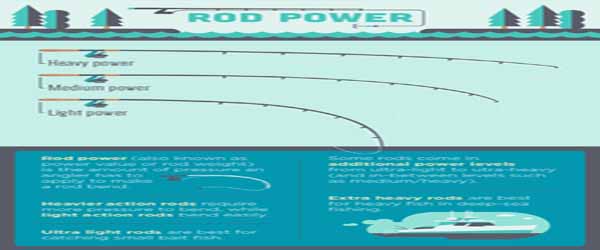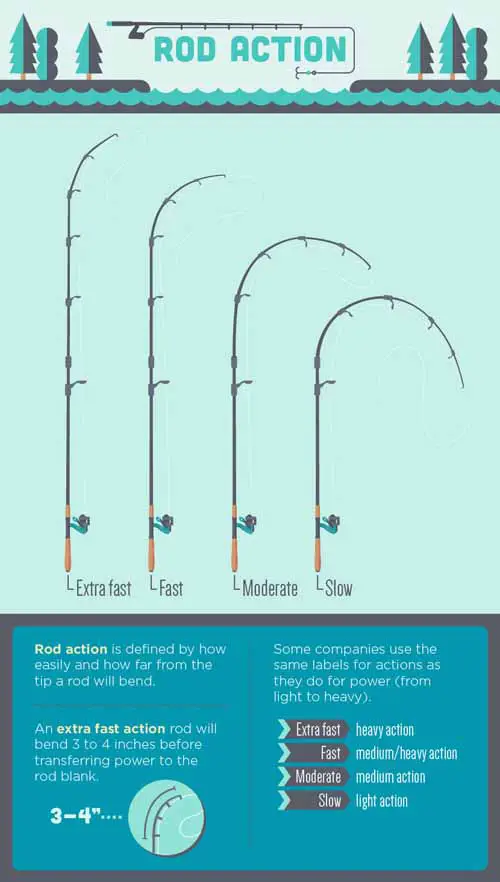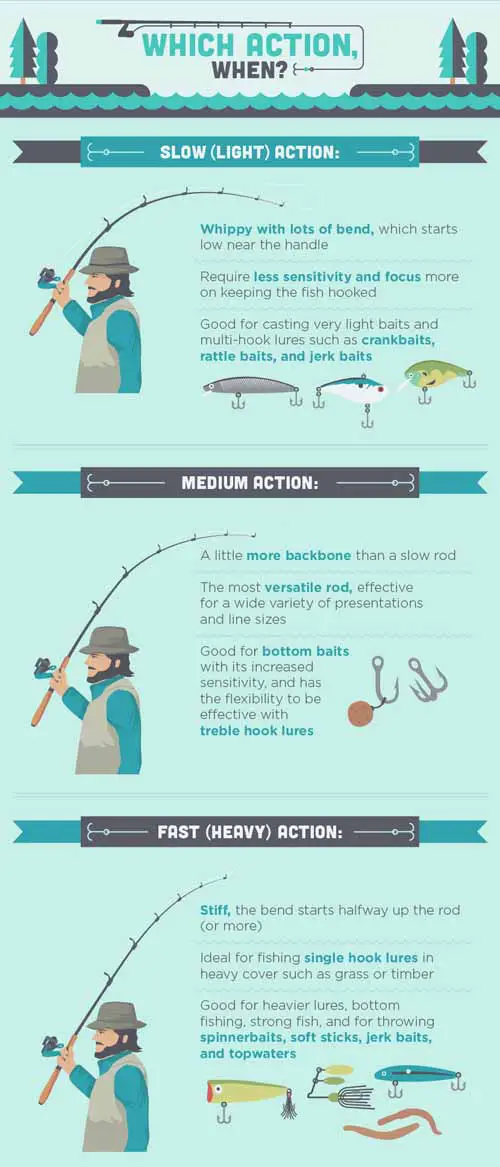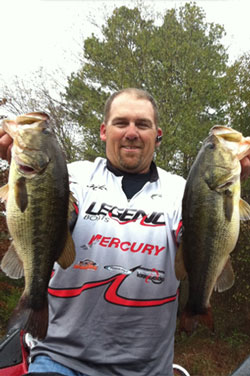Search
Latest Articles
Select the Right Fishing Rod
by Mike Cork for Fix.com, March 26, 2017
Lure Choice
Selecting the perfect bass fishing rod starts with lure choice. A hammer can drive a screw, but is it the most effective tool? Using a flipping rod to fish with crank baits would be just as difficult. While you could cast a crankbait with a flipping rod, the distance, accuracy, and ability to land bass may suffer. Knowing the different parts of a rod – and how they affect casting and fighting a bass – is the first step in selecting the proper rod for the job at hand.
When selecting a baitcasting or spinning rod, there are three things to consider: power, action, and length. The right combination of power and action allows longer and more precise casts with a given lure or technique. Add in the proper length and the combination provides effective control over a hooked bass. All three elements will also prevent angler fatigue.

Power
Power is the amount of pressure an angler has to apply to make a rod bend. Heavier action rods require more pressure to bend, while light action rods bend much easier.1 Rod manufacturers categorize rods as light, medium, or heavy. In some cases, there are in-between levels such as medium/light or medium/heavy. Higher-end rod companies categorize rods with a number system to describe the power rating, usually one through five (one means light action and five means heavy action).

Action
The action describes how and where the rod blank flexes when a force is applied. Or, the action is how easily and how far from the tip a rod will bend. Actions are similar among most rod manufacturers. However, the terms rod manufacturers use to rate these actions can get confusing. Many companies use the same three categories as they do for power ratings: light, medium, or heavy. Other manufacturers use variations of speed to describe action: moderate fast, fast, extra fast. Variations of “fast” better describe how quickly the rod stops bending and transfers power to the blank of the rod. An extra fast (or heavy) action rod will bend three to four inches before transferring power to the blank, which is considered quick. A moderate fast (or light action) will bend nearly a third of the way down the rod blank, which is considered slow.
Action balances the power of the rod for casting and fighting bass. The rod’s action influences how it casts, how sensitive the tip is, and the rate at which it transfers the hook set to the bait at the end of the line. A lighter, slower action will cast lighter baits while a heavier, faster action better suits heavier baits. The action is also useful when fighting a fish once it’s hooked. If you use baits with treble hooks, a lighter action will give when a fish makes a surge, which prevents the hooks from pulling free. However, a lighter or slower action also makes it more difficult to set the hook when a fish strikes. Typically with treble-hooked baits, an angler wants to lean into a strike rather than set the hook. A heavy action allows an angler to drive a hook into a fish’s mouth. Heavy or fast actions better suit baits with single hooks, including a spinnerbait, jig, or Texas rig soft plastics where a strong hook set is required.
To explain how the different power and tip actions improve casting baits and landing fish, let’s compare two bass fishing rods specific to techniques: first, a rod used for fishing crank baits and second, a rod used for fishing spinnerbaits. Both baits have different aerodynamics for casting, and different hooks used to land a bass.
Crank Baits
For crank baits with treble hooks, an angler needs a variation of a medium power and action rod. This lighter action will flex more, which allows for better hook ups when a fish strikes and prevents a fish from pulling loose after it’s hooked. Treble hooks have shallow throats, leaving very little space for the hook to penetrate the jaw of a fish. Treble hooks are designed to grab the skin inside the mouth of a fish. Most crank baits have at least two treble hooks (three hooks on each treble). This gives the angler six chances to get a hook stuck in the fish’s mouth. The medium power and action rod will bend, allowing a bass more time to take a lure deeper into its mouth during a strike. This action also bends when a bass surges or jumps, which again prevents the hooks from tearing free.
A lighter action rod also aids in casting by loading (flexing). When an angler pulls forward to cast, the weight of the lure will flex the rod’s tip. This action builds energy in the flex, called load. The load is then released when the rod comes forward and stops when the bait releases, which allows for a longer cast. Action needs to be balanced with lure weight. A light lure will not flex the rod tip to help casting unless it’s a light action. However, it is possible to overload the rod when casting. And a lure that is too heavy for the rod’s action will prevent the rod from using the load properly. For heavier crank baits, select a heavier action. A good rule is to use the lightest action possible to effectively cast the bait.
Spinner Baits
When fishing with spinnerbaits, use at least a medium/heavy power rod because of the larger single hook. When a bass strikes, a strong hook set is necessary to drive the large single point hook through the jaw of a fish. This may require quite a bit of force. Since spinnerbait’s subpar aerodynamics negatively affect casting distance, you need to balance action with a variety of factors. The size of the bait is the most controllable element. Similar to the crank bait rod, a lighter action will allow for more load and longer distance casts. However, spinnerbaits can get heavy and if the action is too light, the rod may become overloaded, which decreases accuracy. A medium/heavy rod with a fast action provides a great balance for most spinnerbaits up to half an ounce. When fishing baits greater than half an ounce, an extra fast action will provide better casting.

Length
The subject of rod length can lead to debate among anglers. Gary Dobyns, owner of Dobyns Rods, designs a slew of bass fishing rods. “A rod’s length should only be limited to an angler’s ability to use it,” says Dobyns, who would use a 9-foot fishing rod if bass tournaments allowed it. He says longer rods pick up more line on a hook set, which can help if an angler is caught out of position for a good swing. Longer rods can also make up for some of anglers’ errors. “A longer rod is also better at balancing applied pressure against the surges and jumps of a hooked fish,” he says.
In a nutshell, the longer the rod, the more control an angler has over a fish.
Rod Material
Today's fishing rods are made from two materials: graphite and fiberglass. Graphite is the lightest and most sensitive of the two. However, fiberglass still has applications in the fishing industry. When using baits that require a rod with a medium or lighter action, fiberglass provides the necessary parabolic bend (meaning the bend of the rod is similar throughout the length).2Graphite is stronger, more sensitive, and more expensive than fiberglass. A graphite rod, due to its lighter weight and greater sensitivity, is the better choice in most cases.
Line guides
Line guides are nearly as important as the rod’s blank. Quality guides enable anglers to detect strikes transmitted through the fishing line to the rod blank. Line guides range in quality from good to great. The price of each quality level varies tremendously. Micro and standard line guides are the two basic sizes for freshwater casting rods. Micro guides are very small line guides normally used on fly-fishing equipment. In recent years, micro guides have made their way to the casting rod industry, claiming an overall lighter, more sensitive rod. Manufacturers claim anglers can cast further with these guides. A rod with micro guides requires more guides on the blank, so is typically more expensive. Guide size is a matter of opinion. Choose the size that works best for you. Since proper guide placement is vital, examine the rod before purchasing to ensure the guides line up.
Reel Seats
Reel seats are very basic and there aren’t many options. Many anglers prefer a reel seat that allows them to feel the blank with their finger when holding the rod and reel (a cutout on the bottom of the reel seat exposes the rod’s blank). Determining the best reel seat is purely angler preference. Some reel seats are wider than others; trigger placement will vary, along with seat nut size. Hold a variety of rods to find the reel seat that is most comfortable for you. If a rod isn’t comfortable to hold, the perfect combination of length, power, and action is irrelevant. Pay attention to the shape of the grip on spinning rods (some spinning rods don’t have grips). Always test out a reel on the rod you’d like to purchase to see how the combination feels.
Rod Handles
There are a variety of rod handle types available: cork, EVA foam, or a combination of the two. Some anglers prefer the feel of cork to EVA foam. Both are very light and easy to grip. Proper handle length depends on the type of casting. Longer handles help with heavy baits and long casts because they allow an angler to use two hands to generate a lot of load and forward force when casting. For short casts with lighter baits, short handles allow for one-handed or roll casting to targets without getting in the way. Handles also come in split grip, pistol grip, and full grip so an angler can adjust to the type of casting. Full grip handles are best for casting heavy baits or for long distances where two hands are required. For lighter baits or close target casting, choose a split grip or pistol grip. The lack of material in the split grip or pistol grip can reduce the overall weight of the rod. With less material on the handle, manufacturers advertise a split grip handle as more sensitive.
Purchasing the correct rod can be an overwhelming process. But if you stick to these general guidelines, you’ll be in great shape. With the perfect rod, the catch of a lifetime is just a cast away.

Mike Cork has been bass fishing since he was old enough to hold a fishing rod. He's a bass fishing writer, and a current member of B.A.S.S., American Bass Anglers, and Bass Life Associates.
This article was originally published at Fix, an online blog featuring great articles on a large variety of topics. Used with permission.
"We are the Fix Blog, a lifestyle blog devoted to bringing you expert content to make your life easier. We’ll cover everything in and around your home, like landscaping, gardening, outdoor activities, home maintenance and repairs. From products to projects, we’ll be providing you with a daily fix of content from our experienced and knowledgeable team of writers."




